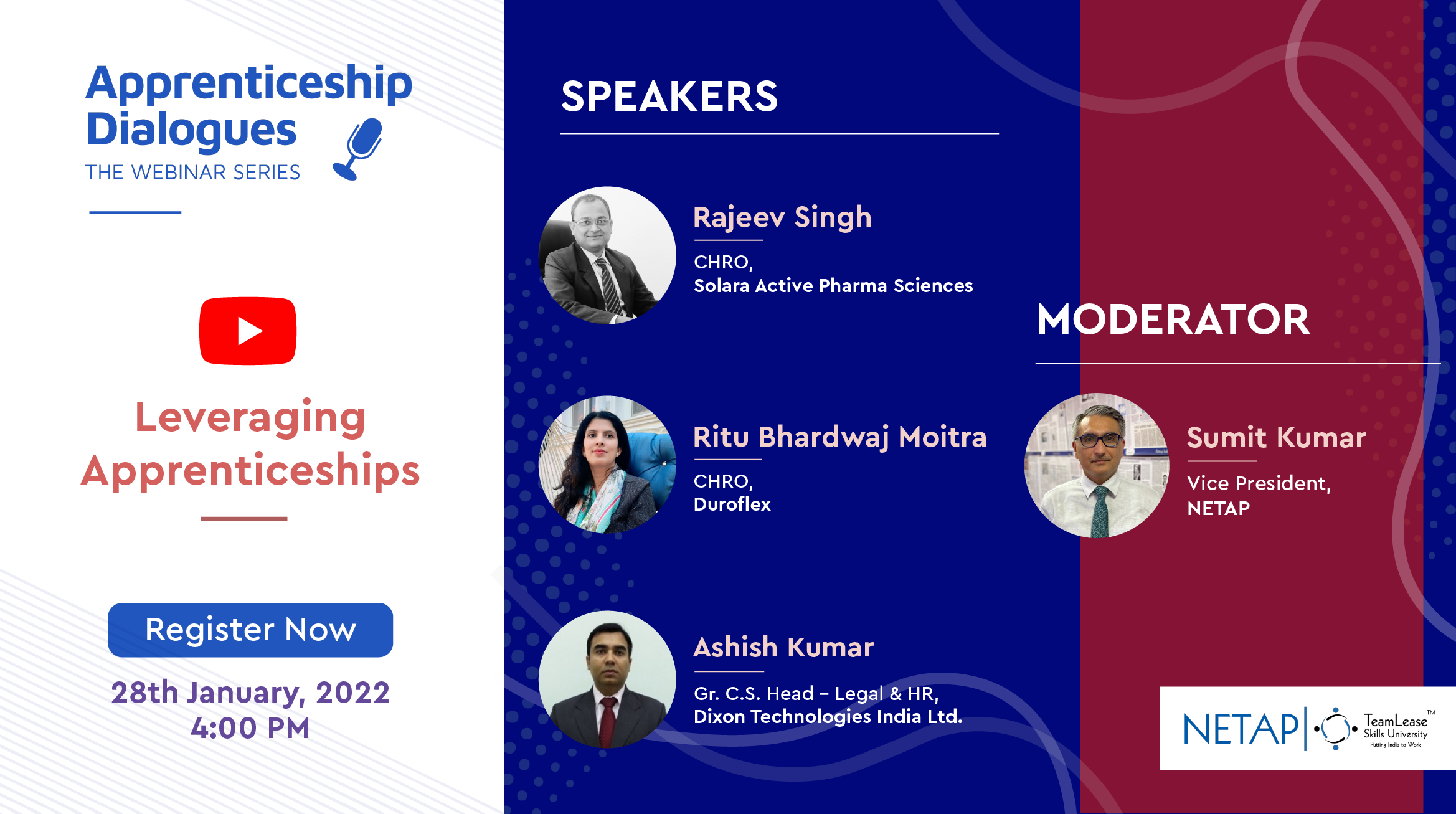About a month back, NETAP launched a report called ROI on apprenticeships, which was actually built up over the first edition - largely focusing on the certain theories and hypothesis spaces on the kind of returns that an employer could get by being invested in apprenticeship. But the second edition was very much backed by the industry research that was conducted with 500 employees to get their opinions and understand their processes. Two interesting outcomes observed from the report were on productivity and hiring cost. Investing in apprenticeships is like investing in equities. The longer you remain invested, the higher returns you're bound to get. And that's what is very much evident in that report. Keeping the same theme in mind, a webinar was conducted on 28th January to discuss leveraging on apprenticeship with 4 industry leaders.
The webinar had an esteemed panel with a very diverse background. Mr. Rajeev Singh, CHRO at Solara Active Pharma Sciences, Ms. Ritu Bhardwaj Moitra, Chief HR Officer at Duroflex, Mr. Ashish Kumar, Head- GR CS Head, Legal & HR, Dixon Technologies India Ltd and Moderator Mr. Sumit Kumar, Vice President, NETAP.
How organizations are leveraging apprenticeships?
Degree Apprenticeships are one of the ways to do talent development for the future pipeline of the workforce and a kind of give back to the society. This not only creates an employment opportunity for the society, but also by training them we are increasing and enhancing their chances of employability. Giving opportunity to the underprivileged part of the society to come into the mainstream workforce. If we look at the scale of the society as a skill center, like the pyramid, the society is a bottom of the pyramid that needs more encouragement and more opportunity for employability. So degree apprenticeship brings a win-win situation for both organizations and trainees. The whole approach of engaging apprentices requires investment, it requires clarity, purpose and investment to keep doing it. Since Ms Ritu Bhardwaj Moitra’s company Duroflex is new to the program as a labor intensive organization, it is quite a simple process driven thing. They are open to get youngsters who have high physical energy and are semi literate. So this way they intend to leverage on getting talent at a very short call, because of the seasonal ins and outs. Watch the conversation here.
Organizations go through some changes or arrangements over a period of time considering that they have been engaged with apprenticeship for some time now. At Dixon technologies they have started focusing more on job training, and increasing the intensity to turn them into real good trained manpower. They have also engaged with various universities to include some degrees or certification to give them encouragement and enhance their employability.The real focus has been on creating a right platform using the right blend of technology. Mr. Rajeev Singh, looks at apprenticeship as a wide talent strategy. Once an organization gets into this, they need to induce practices in a much more structured and disciplined way where it requires interventions at different levels. Watch the conversation here.
Benefits of apprenticeship
Degree Apprenticeship has some qualitative and quantitative benefits on the business of the organization. As mentioned earlier, productivity and cost of hiring are two main benefits that got highlighted in the report. The panelists had some similar experiences with the program. Mr Rajeev said, ‘what comes alongside productivity is the safe working environment and quality of the product maintenance. Many troubleshooting problems get resolved efficiently with the talent in-house.They bring improvement.They bring some different insights’ If organizations have trained manpower, it reduces the chances of error as they are trained with some on job training. And therefore, it definitely impacts productivity in a positive manner. And as a society, unless and until we include everybody and make them gainfully employed, no society, no country can progress. That's another great benefit of apprenticeship. Watch the conversation here.
Apprenticeship needs more simplified system
48% of the organizations don’t even know about degree apprenticeship, Duraflex being one of them. There were a sizable number of organizations who knew about it, but still did not leverage it. So, it requires some more advocacy in terms of making the program more popular, simpler, and easier to understand to get organizations onboard. The policy makers or the labor officers have to come together to popularize this program. At the same time, Ashish suggested some reform in the policies for MSMEs in India. Government could simplify the homes, structure, the whole system, the implementation part, and get into the shoes of MSME to encourage them to try degree apprenticeship. That can align with the Government of India program of creating a lot of employment opportunities and helping the society. The quota that they have fixed on the Apprenticeship Act, the limits that they have put between 15-18, if that can be taken up, go higher up, it will really help to observe and train more apprentices, and create a future talented pool of people. Watch the conversation here.
The webinar concluded with a discussion on how to leverage degree apprenticeship with higher education and gender diversity. Ms Ritu suggested to promote higher education through giving subsidized loans for people who complete their apprenticeship, and are showing a pension for higher education- a more positive way of aligning both work and study together. And speaking about diversity is not a numbers game, chasing a number will lose you out on the main purpose. Diversity is also about bringing different thought processes to an efficient mindset.
The webinar was a successful event with various aspects of degree apprenticeship discussed by the guest speakers. Don’t miss it. Watch the full webinar here.




No comments yet
Your Comment